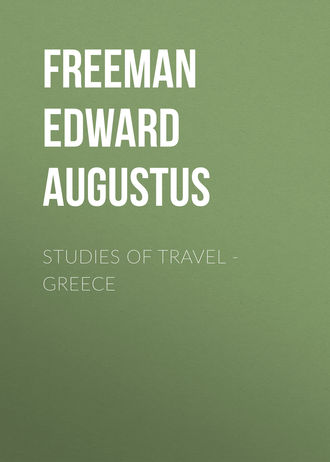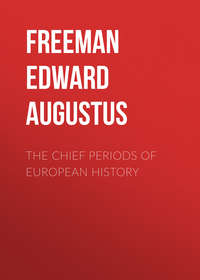 полная версия
полная версияStudies of Travel - Greece
As we get clear of the gulf, by the mouth of Achelôos, the White River of later nomenclature, we are again among the Western islands, though we now see them from wholly different points, and in wholly different relations to one another from those in which we saw them as we first made our way from Corfu round Peloponnêsos. Our course is somewhat erratic; but it enables us to see a coast which has a character of its own and a history of its own. We skirt the shore of Akarnania. Here is a land which has no place in the Homeric Catalogue — a land therefore which has no place in the Hellas of those days, so far as we have any right in these days to make use of the name of Hellas at all. It was then the Epeiros, the nameless mainland, the non-Hellenic shore, as opposed to the Hellenic islands, the realms of Megês and of Odysseus. In the Federal age we find it a Federal commonwealth, weak besides its robber neighbours of Aitôlia, but holding the first place in Greece for what Livy calls the “fides insita genti,” the people who never broke their faith to either friend or enemy. Yet they had enough of worldly wisdom to plead their absence from the Catalogue as a merit in Roman eyes. Aitôlians, Achaians, all the rest, had a share in the overthrow of the mother city of Rome; Akarnania was guiltless. Here is a special history, and the coast has a special character. It is, like other Grecian coasts, a coast of bays and islands and peninsulas; but nowhere else have we seen such a crowd of small islands, mere spots of rock some of them, among which we thread our way, reminding us less of anything that we have seen in Greece than of the northern and more desolate part of the Dalmatian archipelago. There are the Echinades, the Oxeiai, the sharp islands, the urchin islands of later times; but can these dots be Doulichion and the holy Echinai, islands which sent forty ships to the war of Ilios? We pass in and out among them, steering northward between Leukas and the mainland, with the Epeirot mountains in the distant view; but we ourselves do not even reach the channel — after so many changes it is a channel — which divides Leukas or Santa Maura from the mainland. We turn; above the smaller islands rises Ithakê; above Ithakê rises Kephallênia. We enter the haven, as we would believe, of the realm of Odysseus, but not without feeling a difficulty how an island which clearly lies to the north-east can be said to lie πρὸς ζόφον. We pass in and in, hardly dreaming beforehand of the windings of the deep bay which so truly bears the name of Bathy. Scepticism vanishes for a time, and we cannot keep ourselves from greeting the men of Ithakê as countrymen of the elder Odysseus.
But there is still one spot of the mainland to be seen. Before we leave the Hellenic islands, we have still to make another, a more momentary, incursion on the Peloponnêsian mainland. We have seen the sites of Isthmian and Nemeian games; we have still to take a glimpse of the scene of the great festival of Zeus himself. We have passed by the Aitôlian shore; we must visit the great Aitôlian colony. Our last record of Hellenic travel must draw its inspiration from the spot where —
... κραίνων ἐφετμὰς Ἡρακλέος προτέρας, ἀτρεκὴς Ἑλλανοδίκας γλεφάρων Αἰτωλὸς ἀνὴρ ὑψόθεν ἀμφὶ κόμαισι βάλοι γλαυκόχροα κόσμον ἐλαίας.It is hard to conceive the rude Aitôlian discharging such a duty. We may be inclined to fall back on the doctrine of oppressed nationalities, to say,
ἦτοι Πίσα μὲν Διός,but to deny all place as his ministers to strangers from the northern shore of the gulf. What if we make our way to Olympia, under the belief that the Olympiad of B.C. 364, held by genuine Pisatans under the protection of Arkadian spears, was the only lawful celebration of the festival within historic times?
Corinth to Eleusis
We could never understand why Lord Palmerston called the horse-races at Epsom “our Isthmian Games” rather than Olympic, Pythian, or Nemeian. But, as it was Lord Palmerston who said it, the saying was accepted as having some special point; as doubtless many people believed on the same authority that Gothic architecture was a style specially appropriate to Jesuit colleges. The only point of special connexion between Epsom and the games of the Isthmus would seem to be that these last were dedicated to Poseidôn, Ποσειδὼν ἵππιος, and might therefore perhaps seem to be in some way more specially “horsey” than the others. Anyhow the connexion with Poseidôn was a connexion with Thêseus and with Athens, and Athens always claimed a special right in the Isthmian festival, alongside of Corinth its proper president. It was somewhat strange then that, during the century when Corinth was not, the presidency of the games was bestowed on Sikyôn, rather than on Athens, the cherished ally of Rome. But in any case the games supply a link between Corinth and Athens. It is well then that the road — we were going to say between the two cities, but we must now rather say between the village and the capital — lies by the site of the games. We tread the path across the Isthmus which looks so flat from the mountain top, but which we now find to have its ups and downs. We pass by the traces of the stadium; we pass by the foundations of the great temple of Poseidôn; we see traces of the wall which in so many ages has proved so vain a barrier; we see signs of the canal which has been so often no less vainly tried as a means to make the Isle of Pelops truly an island. Now that Athens and Corinth are no longer enemies, the work is more needful than ever. No small amount of commerce which now goes elsewhere would, we are told, pass at once through an Isthmian canal to the haven of Peiraieus. We leave the site of Kenchreia to the right, and take ship again at the modern Kalamaki; we thus better see that northern part of the Saronic Gulf which we saw only in the distance as we passed from Peiraieus to Nauplia. We skirt the shore of Megaris; we better take in the outline of Salamis and its satellite Psyttaleia, the scene of the bloody exploit of Aristeidês. We land once more; we pass along the now familiar road, this time perhaps less anxious than before to catch the first glimpse of the holy rock of Athênê. We may perhaps rather feel that, as we near the olive groves of Kolônos, we are still within the domain of Poseidôn. We may perhaps rather fix our eyes on the lowlier and more perfect Thêseion than on the mightier and more shattered Parthenôn. Fresh from the site of the Isthmia, we are inclined to dwell on the legend which tells us how near Athens once was to being Poseidônia. The sea-god thus follows us on our way back from Corinth to Athens. He will follow us through some of the journeys which we must make in Attica itself, before we steer our course back again to the western shores of Peloponnêsos and to the islands more western still. He who cannot see the whole of the Attic land, he who must be satisfied with picturing to himself from the Athenian akropolis how Agis sent forth his plundering bands from Dekeleia, and how the spirit of freedom set with Thrasyboulos on the brow of Phylê, must at least make his way by the Sacred Way to the holy place of Christendom at Daphnê, and to the holy place of heathendom at Eleusis. He must muse on the mound of Marathôn, not to dream that Greece may yet be free, but to wonder and to hope how soon the freedom which stops at Othrys may reach at the very least to Olympos. He must stand too on the marbled steep of Sounion, no longer to shrink from the land on which he stands as a land of slaves. And on two at least of these three journeys he will still find himself in the company of the same deity who reigned on the Isthmus and on Kolônos. If Dêmêtêr and her child held the first place at Eleusis, yet by the bay which is guarded by Salamis, the sea-god was not forgotten, and on the height of Sounion the two powers who strove for the rule of Athens divided the sacred spot between them. The Isthmus with its games, Eleusis on its bay, Sounion on its height, may all be fittingly taken, as nearly as may be at a glance, as being all of them spots where the sea-god received at least a partial local worship.
The traveller who goes from Corinth to Athens by land will take Eleusis on his way; and those who, like the wearied Ten Thousand at Kerasos, have had enough of their land passage, and who prefer to pass toillessly — it may be asleep like Odysseus — over the waves, may well make Eleusis the object of an early journey after they again find themselves at Athens. We have come back to civilized life. From Athens to Eleusis the journey may be made along the Sacred Way by the same means by which the still abiding wheel-tracks tell us that it was made of old. The journey is one of the highest interest; it is a journey of double interest for those at least who count Daphnê and its abiding church no less worthy of interest than Eleusis and its fallen temple. The Sacred Way of Athens has its Roman parallel; but it is not to be found in the Sacred Way of Rome, but in the road which bears the name of the great Censor. The Sacred Way, like the Appian Way, like all ways more or less, though these two seem to have been conspicuous above others, was a street of monuments, a few of which may still be traced. Parting from the monumental quarter of Athens, from the tombs lately brought to light in Kerameikos, the Sacred Way started from the Dipylon — itself brought to light with the tombs — and passed through the olive groves, leaving Poseidôn’s hill of Kolônos to the right. The starting-point of the modern road is not exactly the same, but the two join at no great distance from the ancient walls. The tombs, which are there no longer, may be studied in the itinerary of Pausanias. But one connects itself with a monument of which some traces are to be found further on. The most splendid of all the monuments by the Sacred Way is that which commemorated the most worthless ashes in its whole course. We feel that Athens had indeed fallen when the most splendid of all the tombs was raised by the son-in-law of Phôkiôn, at the bidding and the cost of Harpalos, to commemorate Pythionikê. Further on our journey we come to the spot where the ancient temple of Aphroditê was turned to the worship of Philê, Philê-Aphroditê, the wife of Dêmêtrios the Besieger. Philê was indeed one of the noblest of women, as Pythionikê was one of the vilest; but tomb and temple alike mark the spirit of a time when strangers were turning the men, and even the gods, of Hellas out of their native homes and altars. But, before we reach the temple of Philê, we reach one of those sites where long ages of Greek history are gathered together in a single spot. There, in the pass, was the temple of Apollo; there, girded by its peribolos, standing on its site with the foundations built out of its stones, is the monastic church of Daphnê. It is well to gaze and study while we can. Daphnê has once been sacked already; here, as at Athens,
Quod non fecerunt Gothi fecerunt Scoti;here, as on the Athenian akropolis, we may curse the name of Elgin, and bewail the columns carried off from their own place to lose beauty, value, and interest in an English museum. And so in our own time the modern spoilers of Athens, in their zeal to wipe out the history of the land, may some day doom the apses, the cupola, the campanile, of Daphnê to be swept away, in the hope of finding inscriptions among their ruins. On a foundation of the temple-stones rises the church with its mingled stone and brickwork, its elaborate windows, its spreading cupola on a far greater scale than those at Corfu or at Athens. And there, perhaps more interesting than all, is the Frankish work at the west end, the defences of the fortified church, raised by the Latin princes, with the contemporary cloister, all alike the work of Western architects on Eastern soil. The barbarians who stole the columns seem to have left something behind them besides mere fragments. An Ionic column embedded in the wall helps to support an arch, once evidently part of a greater number, which carries off our thoughts to the basilicas, not of Ravenna, but of Rome.
Not much further on we can mark wheel-tracks on the rock, and we see the rude foundations — the ἀργοὶ λίθοι of Pausanias — of the peribolos of the temple of the two-fold Aphroditê. We are brought nearer to the days of heathendom, heathendom in so strange a form, when we see the niches carved in the rock to receive the votive offerings — exactly the same fashion which has lingered on in our own times in many churches in Southern lands — and when we see from the inscription Φίλῃ Ἀφροδίτῃ that the Macedonian Queen really had Attic worshippers. By this time we begin better to understand the geography of the country, and to see, what no view from Athens itself would teach us, how strong was the geographical barrier between Athens and Eleusis. This has been well pointed out by Mr. Mahaffy; it is the kind of thing which Mr. Mahaffy, so unlucky on some points, is as well able to take in as any man. In the view from the Athenian akropolis the eye rests on the mountains which part the Attic land from the Bœotian; it passes over the lower range which parts the more specially Athenian land from the Eleusinian. From that range itself, even from the pass that crosses it, we see how completely the two districts were shut out from one another, how — no small point in Grecian political geography — they lie out of sight of one another. We now better understand the tales in the Hymn to Dêmêtêr and in Solôn’s story of Tellos, which set before us Eleusis as a state distinct from Athens, and as having its wars with Athens. We understand how it alone among the Attic δῆμοι kept, in honour doubtless of its sacred character, the name of πόλις, and how once in later times, after Athens was cleared from the Thirty, it did for a moment again become a separate state. We pass along the shore of the bay, by the Rheitoi, the reservoir once sacred to the Eleusinian goddesses, in whose waters only their priests might fish. Then comes the tomb of Stratôn, where we meet with our first sign that Eleusis was a great and flourishing town even in later Roman times. Stratôn had a wife both whose names are Roman; and in the name of her birthplace we get one of those happy misspellings which help us to trace the history of Greek pronunciation. Her description, Πώλλα Μουνατία Ἡράκληα, teaches us that, when the monument was set up, at some time after the days of Pausanias, η and ει had already the same sound, but that Greek αυ no longer represented Latin au.
We have come to Eleusis in the guise of votaries of Poseidôn; but it is to be confessed that, when we reach the sacred city, we have to take it on trust from Pausanias that the sea-god ever was worshipped there. He tells us that there was at Eleusis a temple of Poseidôn the Father; but the remains which we have to study are the remains of the temple of the powers which were emphatically the Mother and the Daughter. Eleusis, like other cities, began as a hill-fort; it still has its akropolis, part of the circuit of whose wall can be traced. It is crowned by a church and bell-tower, of no wonderful architecture certainly, but which we trust may be allowed to abide, even though there may be the ten-thousandth part of a chance that a stone with two or three letters upon it might be found in their foundations. The hill of the Eleusinian akropolis forms a long irregular ridge, rising in the greater part of its course close above the bay, but running a little inland at the point where it becomes an akropolis. It thus leaves a considerable space for the lower city between the hill and the haven. In a walk along the hill, a shattered tower of Frankish times, standing on a nearly detached height, is a prominent object. When reached, it presents no details for study. But in the walk thither we look out on Salamis and the bay which it guards — a lake, as it might seem, between the mainland and the curved island — while on the other side we look down on the Thriasian plain, the plain so often ravaged by Peloponnesian invaders before they crossed the ridge of Aigaleôs to deal havoc in the neighbourhood of Athens itself. And, on the ridge before we reach the tower, one of the smallest and humblest of churches will not be scorned by those who deem that no aspect of the history of the land is beneath their notice. At the foot of the hill, at the opposite end from the tower, lay, as Athens might lie were its haven close at hand, the holy city of the Great Goddesses. At the very end of the ridge, keeping away, as it would seem, from the sea, are the ruins of the temple which was once the greatest in size among the holy places of Hellas. Little now can be made out of its vast circuit. The confused and shattered ruins which are left are those of the temple of Athênê Propylaia. Its plan may be made out with no difficulty; the results may be seen in more than one book from Colonel Leake onward. But one feature, which is not the least instructive of all, seems hardly to have drawn to itself any notice. Among its ruins lie capitals of the same class as those in the baths of Antoninus, capitals in which the traditional trammels are forsaken, and in which a wider scope is given for representation of forms divine, human, or animal. These are memorials of what was in truth one of the most flourishing times in Eleusinian history; when, under the Pax Romana, no Tellos could fight in warfare between Athens and Eleusis, no traitors driven from Athens could find shelter in Eleusis, but when Athens and Eleusis flourished side by side, the one as the university of the world, the other as one of its chief seats of pilgrimage. Are these remains of the temple, as rebuilt by the philosophic Marcus? In any case they are links in that long chain of the history of art which here, as we stand in Eleusis, carries off our thoughts to Lucca and to Wetzlar. The last age then of the glories of Eleusis begins with the saint of heathendom, the prince in whose days the martyrs of Lyons bore their torments and Polycarp played the man at the stake. They were avenged when Eleusis fell before the attack of a Christian and a Teutonic invader. The desolation which we see around us dates from that inroad of Alaric which marked so great an epoch in Grecian history, the great turning-point when pagan Hellas changed into the Christian land which scorned the Hellenic name. Since that day Eleusis has never again raised her head. A time came when she had passed away as utterly as Tiryns or Mykênê. Not an inhabited house was there when Spon and Wheler rode to Eleusis. A small town which had arisen in the days of Leake had become yet smaller during the War of Independence. And now Eleusis seems to be beginning to arise again at the point of her circuit which lies furthest away from her ancient sanctuary. Vessels are in the bay; a modern factory — we forget its exact object — covers a large space between the hill and the sea. Signs of life are to be welcomed everywhere; they are especially to be welcomed when they show that Greece has life in other spots than her encroaching capital. Let the factory grow and prosper; let the vessels come in greater numbers, they will do no harm to what remains of the temple of Dêmêtêr and Athênê; only we should be glad to be equally sure that some æsthetic doctor, Greek or German, may not some day meditate a raid on the churches, the campanile, and the ruined tower.
Sounion
One more excursion, this time not on the Attic soil, but on the Attic sea, must be added to the Eleusinian and the Marathônian pilgrimage, even by those who cannot undertake to follow the keen guidance of Colonel Leake into every corner of the Attic δῆμοι. The survey of the Attic land may well be ended at the point where, in geographical accuracy, it ought, by those at least who approach by way of Syra, to have begun. But to one thus drawing nigh for the first time, Sounion is at most the beacon which points to Athens; it may even be that, if he chances to draw nigh on a dim and cloudy morning, he may fail to distinguish the marbled steep of Sounion among the other lofty points over which his eye wanders. He expects, it may well be, that the height and the temple will front him boldly as the first point of Attic ground to catch his eye. He may not thoroughly take in the fact that the promontory lies in a manner round a corner. Unless he has studied his map very carefully, he may draw near under the belief that the Attic peninsula ends in a point, in the same way in which the three southern peninsulas of Peloponnêsos, that of Tainaros above all, certainly do. Pausanias indeed begins his picture, not only of Attica, but of all Greece, with the “height of Sounion, stretching forth from the Attic land and the mainland of Hellas towards the Kyklades and the Ægæan sea.” Yet it is certain that some who have approached the mainland of Hellas from the Kyklades have not been lucky enough to catch a sight of Athênê on the promontory as a harbinger of Athênê on the inland rock. Even he who is more favoured cannot, at that moment, stop to study the arrangement of the columns which still keep their ancient whiteness. Nor will he, as he sails by, find out that there too the rival of Athênê was not wholly ousted, that the sea-god kept at Sounion a secondary place, at least as important as that which he kept at Eleusis alongside of Dêmêtêr and her Child.
A voyage to Sounion forms then a necessary part of even a short sojourn in Athens and Attica. He who is careful about mines, old or new, might prefer a land journey which should combine Sounion with Laureion. Otherwise it may be better to put oneself under the guardianship of the lord of the dolphins, to whom men prayed on Sounion (ὦ χρυσοτρίαιν’, ὦ δελφίνων μεδέων Σουνιάρατε), and to trust to his golden trident to clear the way. That way leads by several striking points of coast, each cape having, as a rule, an island placed before it as a kind of outpost. Such above all is Zôstêr, where the narrow isthmus, as Dean Blakesley hints, tied the promontory to the shore, but where pious etymologers at a later time saw the spot where Lêtô loosed her girdle. Such an etymology is much of a piece with many popular etymologies in our own land. From the hill of Battle we look out on Telham, so called, says the local legend, because the advancing Norman there told his army. Not far off flows one of the “cold becks” which have given their names to so many spots from Normandy to Scotland. Here it is said to mark the spot where the Duke called back his flying men. The derivation of Zôstêr from Lêtô’s zone is a guess essentially of the same kind as these; yet there is a difference between them which is not uninstructive in comparing the history of the Greek and the English language. In the English derivations the real meaning is absolutely forgotten; wholly wrong words, having merely an accidental likeness in sound, are pressed into the service. In one of the two cases the word thus misapplied has itself in that meaning become obsolete. It is not unlikely that a new legend may arise, and that Telham, instead of the spot where William told— that is, numbered — his army, may become the spot where he told them to do this or that. But Greek had not, in the days at least when the Zôstêr legend was invented, been so utterly broken up as that men were likely to go off to an altogether wrong root. The tale kept within the prescribed range of tying or untying something or other; and Lêtô, Artemis, and Apollôn gained a fresh seat of worship through the etymological guess. But Zôstêr has its place in history as well as in legend. The Persians, after Salamis, took, so says Herodotus, the three small peaks which form the peninsula for Athenian ships, and fled all the more till they found out their mistake. One sceptical historian suggests that it must have been a moonlit night. But, after all, may not this story be less legendary than that of Lêtô, only so far as that real actors are brought in? That the Persians took the rocks of Zôstêr for ships and fled all the more is the kind of mocking saying which was likely to be said at the time, whether true or false. And, even if it was a mere mocking saying, it might well have passed into serious belief before Herodotus, a four-years-old child at the time, had grown into an inquiring historian. After all, the story belongs to a class. There are the thistles which the armies took for spears after the fight of Montl’hery. There are the Welshwomen in the red cloaks, whom the French at Fishguard took for regular soldiers coming to the help of the valiant militia of Pembrokeshire. Did all these things happen, or are they all mere sayings which have found their way into history? Let comparative mythologists argue the point.







